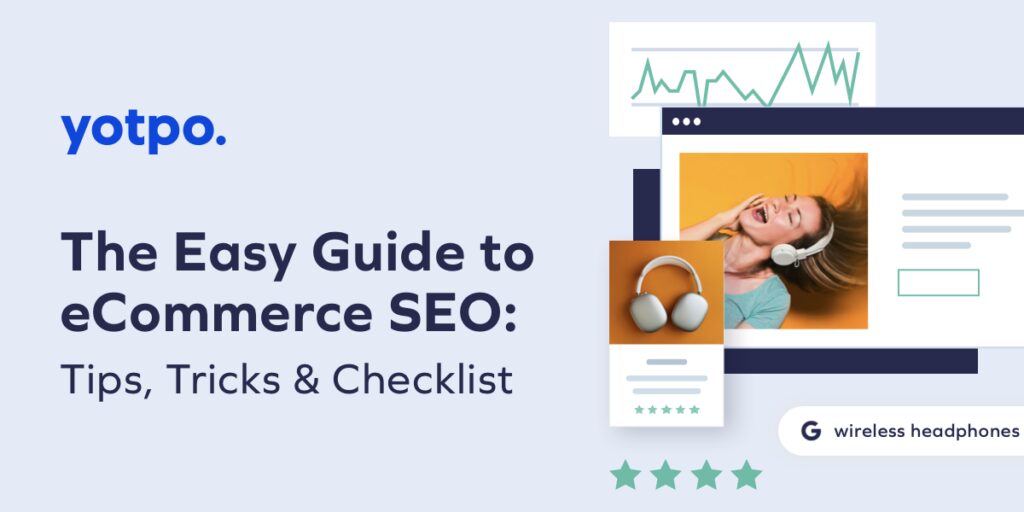
What is Ecommerce SEO?
Search engine optimization (SEO) maximizes online traffic to help brands compete in the current marketplace. By utilizing SEO practices, businesses can improve their ranking on a search engine results page (SERP) to attract more visitors and create opportunities for conversions.
Ecommerce SEO focuses on finding keywords that align with search queries, refining core metrics, updating your product feed, and more.
Choosing Keywords
In order to find the right keywords, you need to choose a keyword tool within budget, such as Google’s Keyword Planner, Moz, Semrush, Ahrefs, or Keywordtool.io.
Once you have a keyword tool, you can compile a list of relevant keywords for your campaign as noted in the ecommerce SEO guide. If you are having a difficult time thinking of keywords, consider analyzing your current website copy, traffic, and conversions; and your competition. From there you can optimize your keyword list based on your findings.
Technical SEO Factors to Consider Are:
- Navigation: 87% of shoppers search for products using uncomplicated digital channels.
- Page speed: The bounce rate rises by 32% when page load times increase from one to three seconds.
- Mobile friendliness: More than 50% of Google searches are done via mobile devices.
- Structured data: HTML markup can display your information as rich snippets on SERPs.
- Broken links: Dead end links negatively impact the way users and crawlers read your site.
- Lack of content: Content that is unique, relevant, and descriptive can improve rankings.
- Duplicate content: This can create confusion for which page Google should push on the SERP.
- Sitemap: URLs should have a structure and be consistent throughout the site. A sitemap helps crawlers understand which pages are important.
Reconfiguring Your Site’s Architecture
Use keywords when naming your categories, subcategories, collections, and products to better your SEO ranking for specific phrases and words. Likely, you will focus on categories, sub-categories, and collections.
- Categories: Products will be grouped under top-level pages. For example, home brands may have the following category pages: living room, dining, kitchen, office, bathroom, and bedroom.
- Sub-categories: Expanding on the category example, home brands may have the following dining sub-categories: tables, chairs, lighting, table linens, decor, serveware.
- Collections: Can include brands, specific styles, sale items, etc.
The ecommerce SEO guide notes that each page should be in hierarchical order within the URL (i.e. homebrand.com/dining/serveware/turkey-platter). You can also consider internally linking to relevant product pages on your website to increase your sales.
After you assign the categories, you can focus on the visitor’s journey on your website. Where will they go to find the information? A few key areas include:
- Menus: Contain the site’s categories, subcategories, and pages.
- Search: Gives customers an easy way to access/find what they are looking for.
- Breadcrumbs: Provide users with an easy way to backtrack to the main category page, etc.
- Footer: A great place to include unique or important pages that you don’t want to include in the menu.
- Filters: Allow users to narrow down the results to meet their requirements (price, size, color, etc.).
Creating Content for Brand/Product Awareness
Relevant and consistent content can create awareness, build consideration, and drive profitable conversions. From blog posts to product reviews, content comes in various forms and benefits different stages of the marketing funnel.
- Awareness stage: Blog posts, podcasts, social media content, guest posts, and influencer content.
- Consideration stage: Guides, email marketing, SMS marketing, quizzes, and interactive tools.
- Conversion stage: Product demos, reviews, testimonials, and galleries.
The ecommerce SEO guide suggests researching your customers’ pain points and competitors’ topics for content ideas. In addition, you should incorporate the keywords that you want to rank for.
Optimizing On-Page and Off-Page Factors
On-Page Factors
On-page SEO optimizes the pages on your site by incorporating your keywords into the title tag, meta description, H1s, etc. Here’s why each location is important within the searchers’ journey.
- Title tag: The initial copy searchers see on a SERP.
- Meta description: A brief section of copy shown below the title tag. The goal is to make this compelling enough for searchers to click.
- H1s: Summarize what the page is about.
- Subheads: Break down the content in a visually compelling way.
- Images: Provide another content medium. Try to incorporate keywords in the image title and alt tag.
Off-Page Factors
Incorporate backlinking in your SEO strategy to increase your site authority and gain new visitors. You can place backlinks on numerous platforms including social media, influencer content, guest posts, and journalists’ pieces.
What is a Technical SEO Audit?
A technical SEO audit should be performed regularly to determine how your content is ranking. By looking at your page speed insights, website’s mobile responsiveness, sitemap, and broken links you can prioritize what needs to be fixed on your ecommerce website.
Choose from free or paid tools to increase your website’s performance, including:
- Ahrefs
- Broken Link Checker
- Google PageSpeed Insights
- Google Search Console
- Google’s Test My Site
- Screaming Frog
- Semrush
- Siteliner
- web.dev
Read Coalition’s contributing section, How to Perform Technical SEO Audits for eCommerce Websites by Jordan Brannon, in the extensive ecommerce SEO guide on Yotpo.

Do I Need This Guide?
If you’re wondering who this guide is actually for, the answer is you! Any website, brand, business, or company, whether an individual or a corporation, can benefit from a reexamination and reapplication of the basics and the fine details of their business’s ecommerce SEO strategy. If you don’t have your strategy yet, now is the time to start, or if you’ve been working with yours for a while, you can use this guide to bring your SEO to the next level.
Use Coalition’s leading SEO expertise to pivot your business towards greater online visibility, leading to more traffic to your website and more resulting sales. Level up your optimization efforts with this helpful ecommerce SEO guide.


